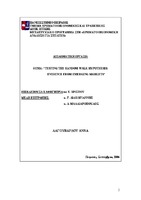Testing the random walk hypothesis : bevidence from emerging markets
| dc.contributor.author | Λαγουβάρδου, Αννα | |
| dc.date.accessioned | 2007-05-23T08:28:18Z | |
| dc.date.available | 2007-05-23T08:28:18Z | |
| dc.date.issued | 2007-05-23T08:28:18Z | |
| dc.identifier.uri | https://dione.lib.unipi.gr/xmlui/handle/unipi/1373 | |
| dc.description.abstract | Using five classical unit root tests, the Augmented Dickey Fuller test, the Phillips Perron test, the Dickey-Fuller test with GLS Detrending (DFGLS), the NG and Perron (NP) test and the Kwiatkowski, Phillips, Schmidt, and Shin (KPSS) test, this paper investigates the return predictability of twenty two emerging markets. These markets are China, India, Indonesia, Korea, Malaysia, Philippines, Russia, Thailand, Taiwan, Czech, Hungary, Poland, Portugal, Slovenia, Turkey, Africa, Egypt, Israel, Argentina, Brazil, Chile and Greece. The data are daily, weekly, monthly and both criteria of the tests (Schwartz and Akaike) are used. Our findings show that the prices of some of the above emerging markets are characterised by random walk. Hence, these markets are weak form efficient since it is useless to predict future returns based on historical ones. | |
| dc.language.iso | el | |
| dc.rights | Αναφορά Δημιουργού-Μη Εμπορική Χρήση-Όχι Παράγωγα Έργα 4.0 Διεθνές | |
| dc.rights.uri | http://creativecommons.org/licenses/by-nc-nd/4.0/deed.el | |
| dc.subject | Διατριβές | |
| dc.subject | Stocks -- Developing countries | |
| dc.subject | Random walks (Mathematics) | |
| dc.subject | Developing countries -- Economic conditions | |
| dc.title | Testing the random walk hypothesis : bevidence from emerging markets | |
| dc.type | Master Thesis | |
| europeana.isShownAt | https://dione.lib.unipi.gr/xmlui/handle/unipi/1373 | |
| europeana.type | IMAGE | |
| dc.identifier.call | 332.64 ΛΑΓ |
Αρχεία σε αυτό το τεκμήριο
Αυτό το τεκμήριο εμφανίζεται στις ακόλουθες συλλογές
-
Τμήμα Χρηματοοικονομικής και Τραπεζικής Διοικητικής
Department of Banking & Financial Management



